As the hospitality industry settles into 2025, developers are balancing optimism with economic realities. Hotel pipelines remain strong globally, though fiscal policies, tariffs, and rising construction costs are shaping investment strategies.
The latest Q4 2024 data from Lodging Econometrics (LE) reveals that the global hotel construction pipeline has reached an all-time high with 15,820 projects—up 4 percent year over year—with more than 420,000 rooms forecasted for 2025 and 2.4 million in the pipeline. The U.S. leads with 6,378 projects, representing 40 percent of the global pipeline, followed by China with 3,779 projects. Currently, 6,231 projects (1.1 million rooms) are under construction worldwide. “These record project counts have been driven by dozens of new brands launched since 2017,” says Bruce Ford, senior vice president and director of global business development for LE. “As the year goes on, expect leisure destinations to drive market performance throughout the world.”
There’s more good news for the travel sector, too. According to the World Tourism Barometer by UN Tourism, international travel in 2024 rebounded to 99 percent of pre-pandemic levels. Preliminary projections indicate that international arrivals will grow by 3 to 5 percent in 2025 compared to last year.
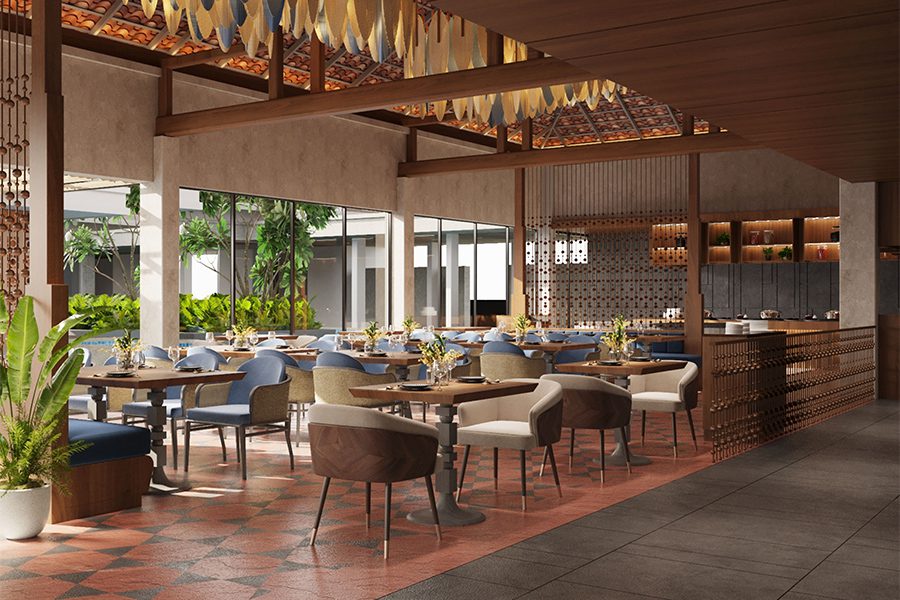
A restaurant at the Hilton Hyderabad Genome Valley Resort & Spa, a 15-acre retreat crafted by Stapati
However, challenges remain. A survey of the UN Tourism Panel of Tourism Experts highlights key hurdles, including rising transport and accommodation costs, economic pressures, and geopolitical risks. “Hotel owners and developers are going to have to remain agile,” says John Fareed, global chairman of Horwath HTL. “We’re going to have to adjust our business and procurement strategies, as well as our construction costs to navigate those economic challenges effectively.”
While costs may seem high today, “it’s only going to be more expensive six or 12 months from now,” adds Michael Coolidge, chief investment and development officer at HRI Properties. “We’ll continue to focus on markets where we think there is strong growth.”
As economic conditions continue to evolve, developers are taking measured steps forward. We spoke with key industry players about their strategies for managing costs, ensuring longterm resilience, and the optimism they have for the road ahead.
Tariff Tradeoffs
After a year of economic uncertainty that kept much of the industry in a holding pattern, momentum is expected to return in 2025.
“Now that we have direction from a government standpoint, a lower interest rate environment, and more economic optimism, developers are willing to take more risks,” says Carl Long, president and CEO of Purchasing Management International (PMI). “Deals that were in the early planning, pre-development, or acquisition and aggregation stage, are starting to move forward.”
As projects gain traction, however, developers must navigate the ripple effects of new and proposed tariffs on China, Mexico, and Canada—key suppliers of FF&E, steel, lumber, and other construction materials to the U.S. To offset rising costs, sourcing strategies are shifting to countries like Vietnam and Thailand, says Larry Traxler, senior vice president of global design services at Hilton. “There was massive Chinese investment in Vietnam to get around tariffs during the [first] Trump administration, so those are relationships we’ve had for a long time. I’m more concerned about Mexico and Canada, because those were also solutions to the previous China tariffs.”
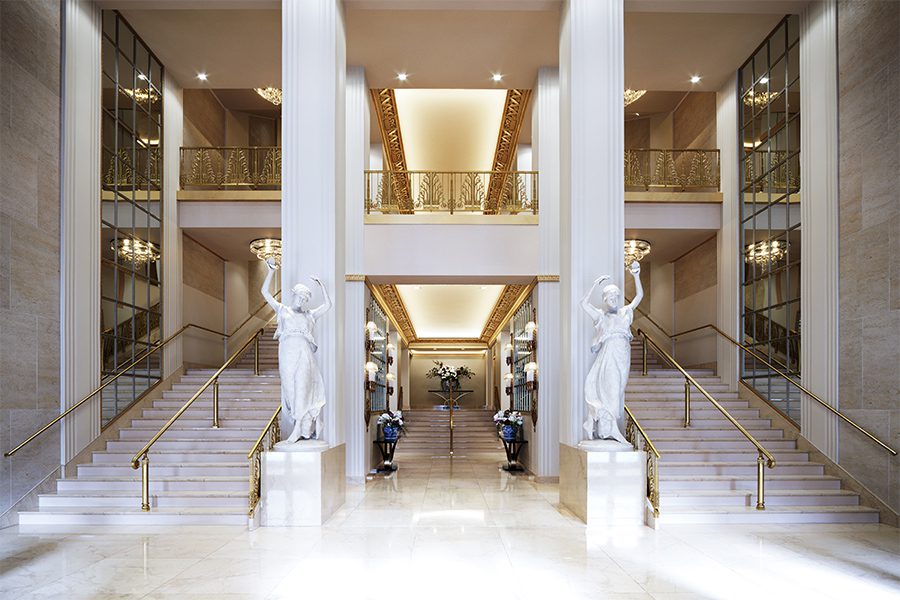
Two statues frame the entrance of the Waldorf Astoria New York, reimagined by SOM and Pierre-Yves Rochon
Developers are also turning to Europe. “We have had—especially for luxury, bespoke, and high-design hotels—a lot more people asking about sourcing in Europe,” says Alan Benjamin, founder and president of FF&E procurement firm Benjamin West. “The labor cost is more than China or Vietnam, but for higher-end hotels, it’s now in the conversation, whereas when the euro was trading around $1.20, it didn’t make sense.”
Domestic production is also becoming more viable in some cases, “where it actually is less expensive to find manufacturers to make the product domestically because of import tariffs,” Long notes. He also sees more projects incorporating longer-term sourcing strategies. “We have projects right now where we are 36 or 38 months out before the product even needs to be ordered,” he says. “That’s a long timeframe since it typically ranges from 16 to 24 [months]. They are even incorporating a sourcing strategy for their FF&E into the [design] specifications.”
Old is New Again
With rising construction costs and tighter financing, adaptive reuse and conversions are becoming a key strategy for developers.
From historic buildings to office spaces and factories, properties are being transformed into luxury hotels, reducing high construction expenses and long permitting timelines. Several adaptive reuse projects are slated to open this year. In Cleveland, the Fidelity Hotel recently debuted in the historic 103-year-old Baker Building, with reimagined interiors by Curioso and Looney & Associates. In Seattle, another Curioso project, Hotel Westland, is set to open in the RailSpur, a collection of adaptive reuse buildings in the city’s Pioneer Square neighborhood. With architecture by Miller Hull, the 120-key hotel occupies a former steam and plumbing supply warehouse built in 1907.
On the West Coast, HRI Properties is transforming a historic 41,500-square-foot YWCA building in Pasadena, California into a 217-key, yet-to-be-named lifestyle hotel. Originally designed in 1921 by American architect and engineer Julia Morgan, the landmark property will complement a newly constructed adjacent building, both of which share a central courtyard.
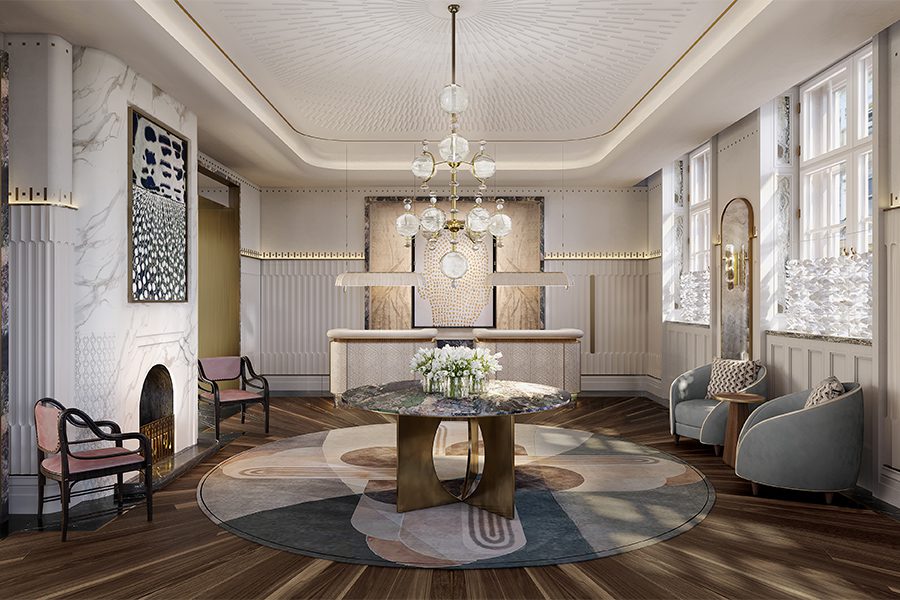
A rendering of the reception area at forthcoming Mandarin Oriental, Vienna, spearheaded by Goddard Littlefair
In Europe, the Mandarin Oriental, Vienna is opening this spring from Goddard Littlefair in a former commercial law court, with 137 rooms and suites surrounding an inner courtyard. Later this summer, the 28-key Vista Ostuni in Puglia, Italy will call a restored 14th-century palazzo home. Designed by architect Roberto Murgia of RMA Studio, the building has served as both a convent and a tobacco-processing factory.
Brand conversions of existing hotels are also on the rise. At the end of Q4 2024, Europe saw a 26 percent year-over-year increase in brand conversions, reaching 520 projects, according to LE. The U.S. is seeing a boost in conversions as well, reaching a record high of 1,336 projects with 128,736 rooms at the Q4 close, according to LE. “They are a big piece of our pipeline,” says Julienne Smith, chief development officer, Americas, at IHG Hotels & Resorts. “Last year, about 40 percent of the deals we signed were conversions. The year before that, it was about 33 and before that, it was high 20s.”
In response to this demand, IHG has introduced conversion-friendly brands like midscale offering Garner and upscale brand Voco. The hotel company also recently acquired Ruby Hotels, an urban lifestyle brand with 20 properties across Europe, many of which have successfully transformed former office buildings into hotels. “The reuse of FF&E across our conversion brands is helping on the cost side,” Smith adds.
Ennismore is experiencing a similar trend. “It’s cheaper to buy than build,” says Mark Eacott, Ennismore’s global vice president of design. “Owners are coming to us, having bought an asset, terminated the previous operator, and now want to bring in an Ennismore brand—and open it within the same year.” Eacott refers to this as rapid takeovers. “It’s a fast track where we have to compress the whole design phase,” he says. “You have to jump phases and be smart. Presentations go from 100 pages to 20. It’s much more of a roll-your-sleeves-up kind of attitude.”
Brand Power
Developers continue turning to mixed-use concepts to create diversified, year-round revenue streams. Branded residences remain a strong driver of this trend, with the latest Savills data revealing 740 completed developments worldwide and an additional 790 slated for completion across 100 countries by 2031.
Driven by buyers seeking top-tier amenities—wellness centers, coworking spaces, art studios, and more—branded residences are often paired with luxury hotels. “[It’s] one of the fastest growing sub-sectors we’ve seen over the last five years, and it’s going to continue to fuel luxury hotel growth,” says Lori Horvath, managing director at JLL, a global real estate and investment management company. “Nearly 70 percent of all the proposed luxury hotel developments [in the JLL portfolio] have a branded residential component included within them.”
From a business perspective, branded residences boost sales by offering buyers the confidence of familiar names, typically commanding 30 to 40 percent above market comparables, and many sell out during presale. For instance, Marriott’s W Residences in Dubai, opening in 2027, sold out in just 30 days, while the 69 residences at the St. Regis Longboat Key Resort and Residences in Florida were fully sold out more than a year before opening.
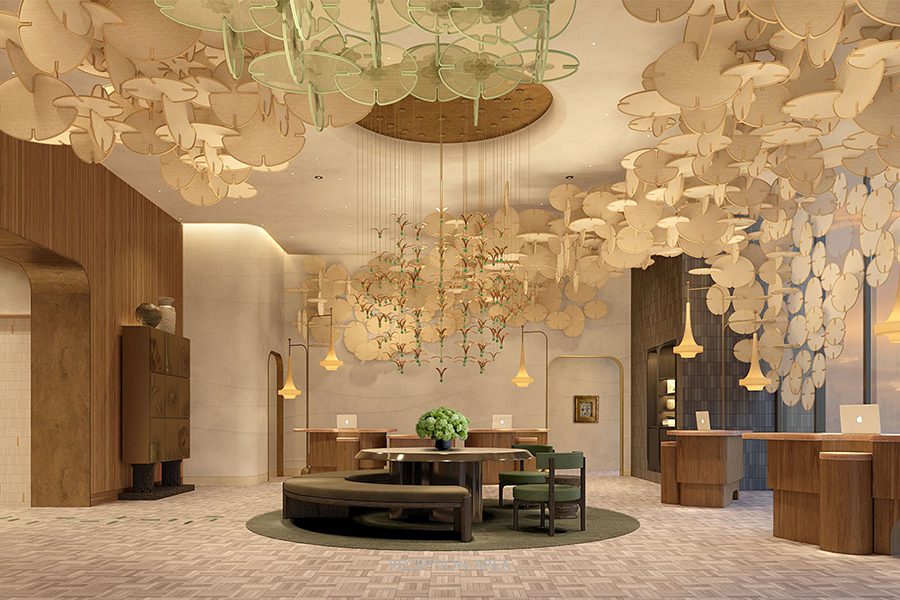
A rendering of a striking ceiling installation at the yet-to-open KROMO Bangkok, Curio Collection by Hilton, a collaboration between Marc & Chantal and DIN Studio
Beyond hospitality, the trend has expanded to non-hotel brands—fashion houses like Fendi and automotive giants such as Porsche and Bentley have entered the space. They are even gaining traction outside of the luxury segment. “We’ve been doing Waldorf and Conrad branded residences for years, and now we’re starting to look at it for Canopy and Curio,” notes Traxler.
Members clubs and nightlife are also becoming key components of mixed-use hospitality. Six Senses London, opening this year in a restored Art Deco building with architecture by Foster + Partners and interiors by EPR Architects and AvroKO, will include 109 rooms, 14 branded residences, and Six Senses Place, a new social and wellness club featuring a central bar and lounge, coworking spaces, a restaurant, and treatment rooms. Meanwhile, Miami-based luxury hotel group Faena will debut a mixed-use project inside a Bjarke Ingels Group-designed building at New York’s High Line this spring. The property will feature 120 guestrooms and suites, the Tierra Santa Healing House, F&B venues, and a dynamic nightlife program.
Larger mixed-use developments are also underway in smaller markets. In Tempe, Arizona, the $1.8 billion South Pier project will feature more than 500 hotel rooms, 2,500-plus residential units, 600,000 square feet of office, restaurant, and retail space, as well as expansive green spaces and resort-inspired amenities like wellness centers and game rooms. Similarly, Pittsburgh’s Esplanade development recently broke ground, which will bring a 225-key hotel, 300 apartments, F&B concepts, retail, an aquarium, and more to the city.
On a global scale, Saudi Arabia’s Diriyah Company is spearheading an ambitious giga-project in Diriyah, designed to honor the Kingdom’s rich heritage with 40 hotels, more than 300 branded residences, dynamic retail districts, and 17 million square feet of office space.
Stay Well
Wellness amenities also continue to be a major component of many properties. “I can’t imagine building anything now without incorporating some kind of wellness facility,” says Fareed.
Take Ameyalli, a longevity-focused residential community built around a natural geothermal spring in Midway, Utah. Designed by Overland Partners in collaboration with the Chopra Foundation, the nature-forward project includes residences, which are already open, as well as an 80-room hotel and a sprawling 50,000-square-foot Ameyalli Wellbeing Center, slated for 2027. The center will feature a subterranean mineral pool, a 55-acre natural geological preserve, and a biodiverse garden supporting the property’s garden-to-table dining program.
Another wellness-forward mixed-use project, the Well Bay Harbor Islands in Miami, is set to launch in Q2. A collaboration between Arquitectonica and Meyer Davis, the development will feature 66 condominiums, nearly 94,000 square feet of office space, and a 17,000-square-foot wellness haven.
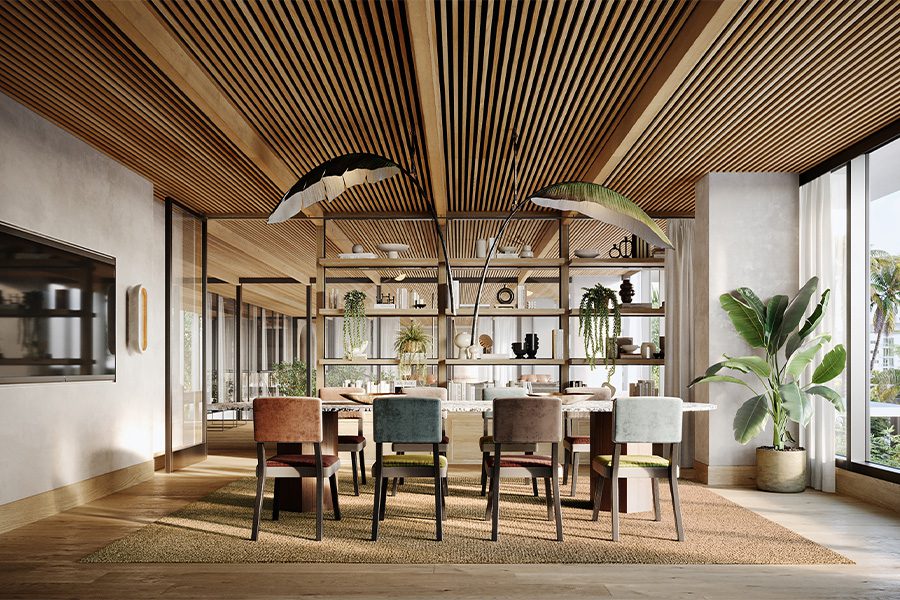
Arquitectonica and Meyer Davis teamed up on the forthcoming Well Bay Harbor Islands in Miami, shown in a rendering
“We’re seeing medical and sciences come into play on properties where you can’t just have a spa and treatment rooms or dipping pools anymore,” says Steven Upchurch, principal and co-managing director of Gensler’s Dallas office. One brand that has been a pioneer in the wellness space is Six Senses, exemplified in Six Senses the Palm, Dubai, slated to open later this year, with architecture by Brewer Smith Brewer Group and SAOTA. Anchored by a 60,000-square-foot social and wellness club, the property will include a longevity clinic, IV lounge, biohacking room, massage circuit pool, squash court, coworking spaces, and a spa—alongside biophilic design elements that promote natural circadian rhythms throughout the interiors.
Small But Mighty
Despite potential business challenges, development remains strong in urban centers worldwide. According to LE, 6,231 projects are under construction in central business districts, with 1,149 in the U.S. Major hubs like New York—where 166 projects are in the pipeline—remain key markets, with standout projects like the SOM- and Pierre-Yves Rochon-designed Waldorf Astoria New York debuting this year alongside the 173-room new-build Xadia Hotel by Marin Architects. However, secondary cities are also experiencing a notable development boom.
Dallas leads the U.S. hotel construction pipeline with a record-breaking 204 projects for 23,669 rooms. This growth is fueled by corporate migration, bolstered by the expansion of the Kay Bailey Hutchison Convention Center Dallas and the $1.6 billion renovation of the Dallas Fort Worth International Airport, set for completion in 2026. “Dallas, and Texas in general, was very corporate-friendly during the pandemic and has put a lot of incentives in place for companies to [relocate there],” says LE’s Ford. “It’s had a large corporate influx and population growth as they continue to create more layers of suburbia.”
This is also driven by business travel to Texas because of an increase in manufacturing, which “tends to have a hospitality component around them,” says Upchurch. “There’s also movement of financial services like Goldman Sachs to Texas, along with other large headquarters—you follow where they’re migrating to.”
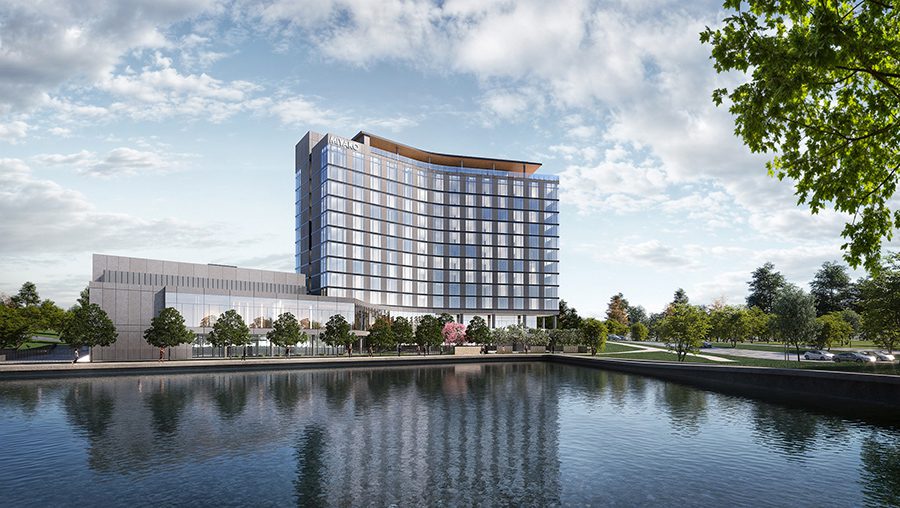
Gensler blends Japanese and Southern-style design at the the Miyako hotel in Texas, shown in a rendering
Gensler’s current project, the Miyako Hotel in Plano, Texas, 20 miles north of Dallas, is a 13-story, 217-key hotel that will provide a curated experience not just to guests but also the community. “More often than not, we try to get more than one F&B experience beyond what the brand may already offer,” Upchurch adds. “This allows the retail component to become more embedded into the fabric of the city, becoming a destination in itself.”
This extends across the Sun Belt as well, with Atlanta (168 projects) and Nashville (130 projects) following closely behind Dallas. In Nashville, the Printing House Hotel, part of Hilton’s Tapestry Collection, will open this spring with 187 midcentury-style guestrooms, designed by Ratio Architects and Manuel Zeitlin Architects. Just blocks from the city’s famed Honky Tonk Highway, the hotel is crafted with the local community in mind, featuring Letterpress Lounge & Terrace, a rooftop music venue, and the Press House café on the ground floor.
This emphasis on F&B spaces is a continued priority for hotels in the U.S., as both guests and locals are increasingly drawn to highly detailed culinary experiences. “That’s something we’re picking up on,” Justin Ried, senior vice president of pre-development, design and construction at real estate investment trust Host Hotels & Resorts. “There’s a lot of focus on bars—[people] want to be able to see that experience right as they’re coming into the hotel.”
“Generally, urban markets are strong and our research shows that will continue,” notes JLL’s Horvath. “This year, New York, Chicago, New Orleans, and others have strong leisure demand. But there is also a resurgence of group and corporate travel, not only in the major markets, but also in secondary and tertiary markets.”
In response to the growing demand in New Orleans, for example, Omni Hotels & Resorts has secured approval for a 1,000-key hotel at the New Orleans Ernest N. Morial Convention Center. The $575 million project, set to begin construction in 2026 with a projected 2029 opening, will feature 100,000 square feet of meeting space, multiple F&B venues, a rooftop pool deck, and a destination spa.
Resort Renaissance
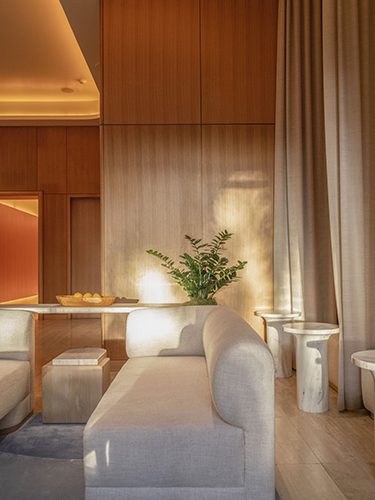
A serene spa lounge at the Conrad Orlando, crafted by HKS and Anderson/Miller
While city centers are seeing a surge in hotel development, resorts worldwide are also experiencing significant growth. “Many resort markets continue to outpace industry performance,” Ford notes.
In the U.S., Orlando, Florida remains a hotbed of activity, with 28 resort projects in the pipeline, including five slated to open this year, according to LE. The 500-key Helios Grand Hotel will make its debut this May alongside the highly anticipated Epic Universe theme park. Meanwhile, Villatel Orlando Resort is gearing up to welcome guests with 526 apartments, villas, and estates, complemented by 200,000 square feet of amenities, including an expansive water park. Also opening this year is the Conrad Orlando, a collaboration between HKS and Anderson/Miller. The resort greets visitors with a dramatic atrium, floating canopy, and statement pieces, while the interiors flaunt a palette inspired by sand and water.
Beyond the U.S., the Asia-Pacific region is emerging as a key resort market, particularly India. “Previously, China was the focus and now India is the next country that will have a big influence on global travel demand,” says Ford. “Many luxury resorts and upper-upscale brands are expanding into more destinations across India.”
At Marriott, “India is our fifth largest market as a company, with an exciting pipeline of 103 properties [there],” says Diana Plazas-Trowbridge, chief lodging product officer, U.S. and Canada, at Marriott International. “There’s a growing middle class in India. Air India made the largest new plane order out of any airline out there. There is a lot more domestic and outbound travel.” Among Marriott’s upcoming openings is the Jim Corbett Marriott Resort & Spa, debuting in Q1 in Uttarakhand, Northern India, at the Himalayan foothills. The 99-room resort will feature four dining venues, a kids club, Quan Spa, an arcade, and jungle safaris. Also launching this quarter is the Hilton Hyderabad Genome Valley Resort & Spa, a 15-acre retreat designed by Stapati.
Meanwhile, the Middle East, with a luxury pipeline of 179 properties, is also focusing on the resort sector. “The number of deals that have been signed since the beginning of the year in the Middle East is shocking,” says Traxler. “Capital investment is not the concern—they find ways to [fund projects] and get things moving.”
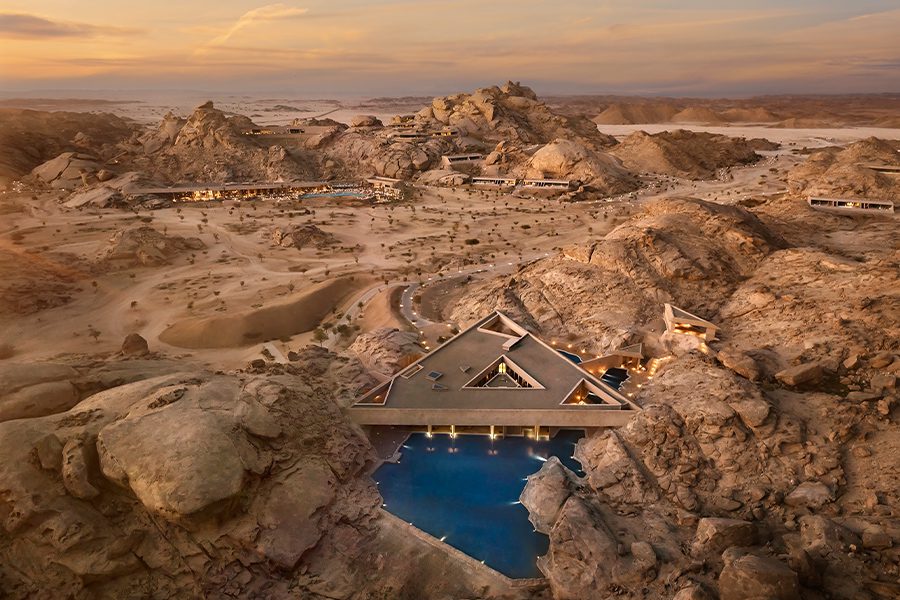
Desert Rock, nestled in Saudi Arabia’s Hejaz Mountains, features architecture by Oppenheim Architecture and interiors from Studio Paolo Ferrari
Consider Saudi Arabian real estate development company Red Sea Global, which is expanding its portfolio with 16 resorts opening this year, and 50 slated by 2030. The company recently unveiled Desert Rock, an immersive resort embedded into Saudi Arabia’s Hejaz Mountains by Oppenheim Architecture and Studio Paolo Ferrari.
Another standout is Shebara, a striking overwater resort of stainless steel, orb-like villas seemingly floating above the ocean, envisioned by Killa Design with interiors by Studio Paolo Ferrari and Rockwell Group. “It was [about] connecting back to the architecture and expressing the qualities of the location,” says Paolo Ferrari, founder of his eponymous firm. “The extra-white travertine is warm and connects us back to the tonality of the pristine sand. The deep red was a counterpoint to the turquoise blue water that is perceived from all areas of the guestroom.”
Despite being mired in a handful of controversies, including human rights issues, environment impact, and financial concerns, NEOM—the futuristic mega-city project in Saudi Arabia—is forging ahead. Touted as a global hub for innovation, technology, and sustainable living, the $500 billion project has already attracted a handful of global brands including Hyatt, Marriott, Raffles Hotels & Resorts, and Habitas, among others. Both developments are part of the Saudi Vision 2030 plan to bring more tourism and create more business for the country.
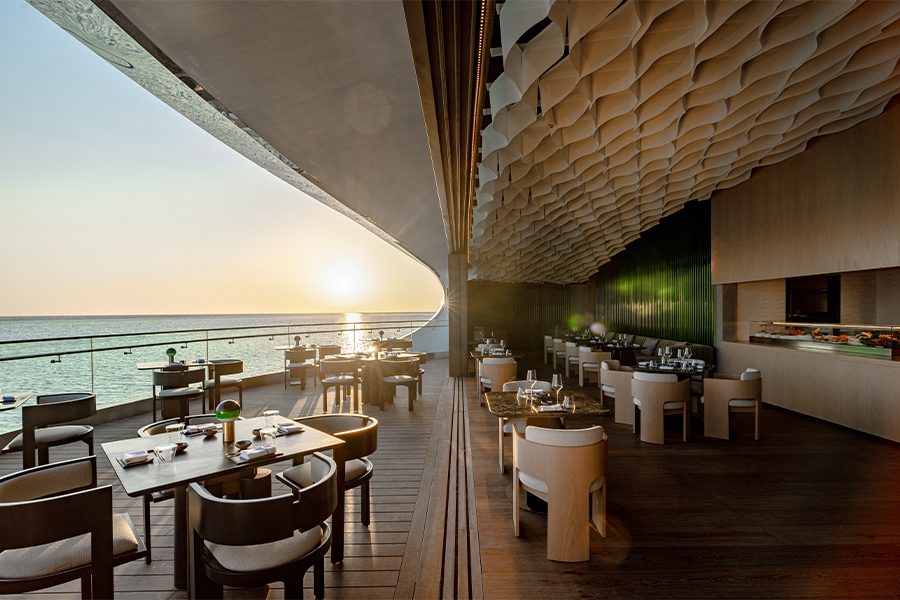
The Rockwell Group-designed Iki Roe restaurant at Shebara Resort features an indoor-outdoor dining experience
Additionally, the UAE issued its first gaming license to Wynn Resorts, a step forward for the under-construction Wynn Al Marjan Island Resort in Ras Al Khaimah, which is expected to open in 2027 with a gaming floor, more than 1,500 guestrooms, convention facilities, 22 restaurants, an expansive poolscape, and a shopping promenade.
All-inclusive resorts also are gaining momentum, especially in Latin America, where a wave of openings is reshaping the sector. Hyatt’s recent $2.6 billion acquisition of Playa Hotels & Resorts, which operates 24 all-inclusive luxury properties across Mexico, Jamaica, and the Dominican Republic, underscores that growth potential.
This January, TROBBU Tulum in Mexico introduced the region’s first all-inclusive luxury villa experience. Designed by Manoumana, the boutique retreat features 10 villas, each spanning 2,745 square feet across three floors, with private pools and tailored guest experiences.
On a larger scale, Zemi Miches All-Inclusive Resort, Curio Collection by Hilton will open in June in the Dominican Republic. Designed by Simples Arquitectura, with interiors by Hoyos Design Studio and Arkham Projects, the 500-room resort draws inspiration from Taino culture. The property will boast 11 F&B venues, a rooftop pool, a sprawling pool complex with a water park, a kids and teens club, and retail shops.
Going Green
“I don’t think it’s optional anymore,” says Fareed on the growing importance of sustainable practices. From an economic perspective, integrating energy efficiency, waste reduction, and water conservation can be “win-wins between corporate responsibility and tax or community benefits,” he adds.
According to JLL’s global sustainability report, 78 percent of travelers are more likely to choose sustainable hotels, “and that tells a story,” adds Horvath. “Hotels are integrating these strategies because they’re seeing reduced operational costs through energy and water conservation.”
Some brands are continuing to go full steam ahead. “With Six Senses, there’s no holding back,” shares IHG’s Smith. Since its founding in 1995, the brand has been on a mission to eliminate plastic from its properties. Last fall, it introduced the Journey to Plastic Freedom Playbook, offering tested solutions for removing plastic from hotel operations.

An aerial view of the garden at Six Senses Laamu resort in the Maldives
IHG’s commitment extends beyond Six Senses, too. The company recently launched the Low Carbon Pioneers Program, which identifies low-carbon, energy-efficient hotels within its portfolio that run on renewable energy. These properties serve as test cases to help evolve sustainability standards across the entire brand.
Sustainability isn’t only about the final product—it starts in the construction phase. “One of the things that people don’t talk about when we talk about supply chain logistics is the massive amount of energy and labor and materials that are being reallocated [to project sites],” says Traxler. This is where modular construction can be advantageous, meaning components of a project are built in a controlled factory setting rather than onsite, reducing the amount of waste and energy while lowering build cost marginally and increasing speed to market.
The recently opened Treehouse Hotel in Sunnyvale, California, with architecture by 10SB and interiors from Crème, for instance, is pioneering modular construction. Developed by FullStack Modular in partnership with Synergy Modular, the 143-room property from SH Hotels & Resorts utilizes offsite manufacturing techniques to produce fully integrated modules, including façades, hallways, elevator shafts, stairwells, and finished hotel rooms.
Meaningful Moments
In the end, today’s travelers are seeking meaningful connections to their destinations—whether through wildlife encounters, cultural exchanges, or hands-on local experiences.
“For our Middle East and Africa team, interest in tented lodges and safari experiences—both in the luxury and premium markets—is incredible,” says Plazas-Trowbridge. Such experiences are flourishing across Africa. The Anantara Kafue River Tented Camp will soon debut in Zambia’s Kafue National Park, while andBeyond Suyian Lodge (the handiwork of Nicholas Plewman Architects and Michaelis Boyd) will open this July in Laikipia, Kenya, offering safari adventures and dining beneath the stars. In South Africa, eco-luxury brand Few & Far introduced its first lodge, Few & Far Luvhondo, this January. Also designed by Nicholas Plewman Architects with interiors by Ohkre Collective, the six-suite retreat is perched among ancient baobab trees and serves as a gateway to the UNESCO-listed Vhembe Biosphere Reserve.
Marriott also sees potential in bringing these outdoor accommodations stateside, by signing a longterm agreement with outdoor hospitality brand Trailborn as well as acquiring Postcard Cabins, formerly Gateway, a pioneer in the sector with 29 locations across the U.S.
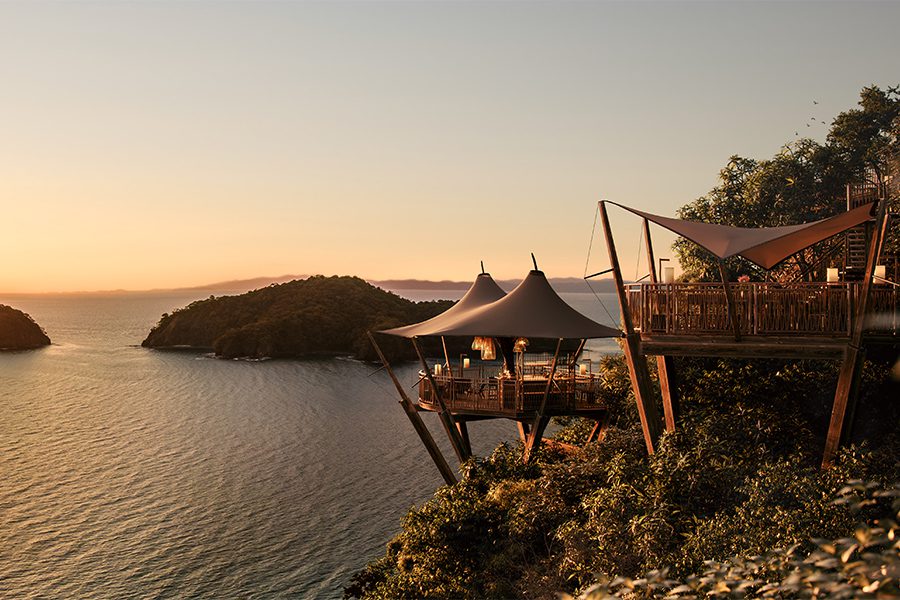
Ambar, a suspended treetop bar at Nekajui, a Ritz-Carlton Reserve, overlooks the Pacific Ocean, shown in a rendering
Beyond nature-based experiences, cultural immersion is also shaping the future of hospitality. At NIHI Sumba, 285 miles east of Bali, guests not only have access to the natural land and sea, but also to cultural programming like traditional cooking classes and ikat weaving, an ancient art form passed down by Sumbanese artisans. The brand is expanding with NIHI Rote, a sister property opening in November 2025 in a secluded corner of Timor Island.
“Immersive hospitality is a concept where every guest experience—from the design and amenities to the activities and services—is designed to engage all of your senses, emotions, and curiosity to create lasting memories,” says Fareed. “It encapsulates our efforts as an industry to redefine what it means to stay in a hotel or resort. It’s about offering something that goes beyond luxury or convenience into the realm of something that’s more meaningful and unforgettable.”
This article originally appeared in HD’s February/March 2025 issue.








